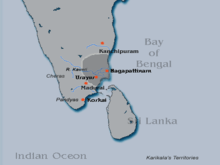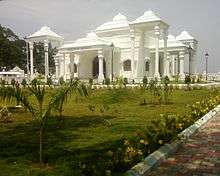Karikala
| Karikala Cholan | |
|---|---|
|
Peruvaḷattān Tirumāvaḷavan Parakesari[1][2] | |
.jpg) Bronze statue of Karikāla Chōḻaṉ | |
| Reign | c. 145 BCE [3] |
| Predecessor | Ilamcetcenni |
| Successor | Nalankilli |
| Queen | Alli – Velir princess |
| Issue |
Nalankilli Nedunkilli Māvalattān |
| Father | Ilamcetcenni |

| List of Chola kings and emperors | ||||||||||||||||||||||||||||
|---|---|---|---|---|---|---|---|---|---|---|---|---|---|---|---|---|---|---|---|---|---|---|---|---|---|---|---|---|
| Early Cholas | ||||||||||||||||||||||||||||
| Interregnum (c. 200 – c. 848) | ||||||||||||||||||||||||||||
| Medieval Cholas | ||||||||||||||||||||||||||||
|
||||||||||||||||||||||||||||
| Later Cholas | ||||||||||||||||||||||||||||
|
||||||||||||||||||||||||||||
| Related dynasties | ||||||||||||||||||||||||||||
|
||||||||||||||||||||||||||||
| Chola society | ||||||||||||||||||||||||||||
| Part of a series on |
| History of Tamil Nadu |
|---|
 |
Karikala was a Chola king who ruled in southern India during the Sangam period. He is recognised as the greatest of the Early Cholas.
Sources
The story of Karikala is mixed with legend and anecdotal information gleaned from Sangam literature. The only sources available are the numerous mentions in Sangam poetry. The period covered by the extant literature of the Sangam is unfortunately not easy to determine with any measure of certainty.
Paṭṭiṉappālai, Poruṇarāṟṟuppaṭai and a number of individual poems in the Akanaṉūṟu and Purananuru have been the main source for the information that is attributed to Karikala.
No authentic records of Karikala's reign have been found so far. However many rulers and petty chiefs who came after him claimed him as their ancestor and decorated themselves as belonging to the solar race of Karikala and of the Kashyapa gotra.[4][5]
Early life
Karikala was the son of Ilamcetcenni.[6] The name Karikalan has been held to mean "the man with the charred leg" and perpetuates the memory of a fire accident in the early years of his life. Some scholars also hold the view kari and kalan are Tamil words meaning "slayer of elephants". Poruṇarāṟṟuppaṭai describes the back-formed origin legend of this incident as follows:
The king of Urayur Ilamcetcenni married a Velir princess from Azhundur and she became pregnant and gave birth to Karikala. Ilamcetcenni died soon after. Due to his young age, Karikala's right to the throne was overlooked and there was political turmoil in the country. Karikala was exiled. When normality returned, the Chola ministers sent a state elephant to look for the prince. The elephant found the prince hiding in Karuvur. His political opponents arrested and imprisoned him. The prison was set on fire that night. Karikala escaped the fire and, with the help of his uncle Irum-pitar-thalaiyan, defeated his enemies. Karikala’s leg was scorched in the fire and from thence Karikala became his name.
Old Sangam Age inscriptions and also sthala puranam of great ancient Saiva shrine at Parasalur, near Mayavaram says that in order to escape the murder plot hatched by conspirators Karikal Valavan stayed there in disguise of a vedic and agama sastra lecturer for eight years. Paṭṭiṉappālai, written in praise of Karikala also describes this incident, but without mention of the fable of the burnt limb:
Like the Tiger cub with its sharp claws and its curved stripes growing (strong) within the cage, his strength came to maturity (like wood in grain) while he was in the bondage of his enemies. As the large-trunked elephant pulls down the banks of the pit, and joins its mate, even so after deep and careful consideration, he drew his sword, effected his escape by overpowering the strong guard and attained his glorious heritage in due course.
Military conquests
Battle of Venni
According to the Poruṇarāṟṟuppaṭai, Karikala Chola fought a great Battle of Venni in which both Pandyan and Cheran kings suffered a defeat.[7] Although we know very little about the circumstances leading to this battle, there can be no doubt that it marked the turning point in Karikala’s career, for in this battle he broke the back of the powerful confederacy formed against him.[8] Besides the two crowned kings of the Pandya and Chera countries, eleven minor chieftains took the opposing side in the campaign and shared defeat at the hands of Karikala.[9][10] The Chera king, who was wounded on his back in the battle, committed suicide by starvation. Venni was the watershed in the career of Karikala which established him firmly on his throne and secured for him some sort of hegemony among the three crowned monarchs. Venni is also known as Vennipparandalai and now it is known as Kovilvenni and is situated near Thanjavur.[11]
Further wars and conquests
After the battle of Venni, Karikala had other opportunities to exercise his arms. He defeated the confederacy of nine minor chieftains in the battle of Vakaipparandalai. Paranar, a contemporary of Karikala, in his poem from Agananuru mentions this incident without giving any information on the cause of the conflict.[11] According to legends Karikala was one of the few Tamil kings who won the whole of Ceylon (Lanka). The Grand anicut was built after his conquest over the Singalese kingdom and he used Singalese war prisoners for the hard task of moving stones from the mountains to the river bed of the Kaveri. The Pattinappalai also describes the destruction caused by Karikala’s armies in the territories of his enemies and adds that as the result of these conflicts, the "Northerners and Westerners were depressed… and his flushed look of anger caused the Pandya’s strength to give way…".
Grand Anicut
Later Chola kings attributed the building of dikes along the banks of the Kaveri to Karikala.[7][9][12][13] The raising of the banks of the river Kaveri by Karikala is also mentioned by the Melapadu plates of Punyakumara: karuna – saroruha vihita – vilochana – pallava – trilochana pramukha kilapritvisvara karita kaveri tira (he who caused the banks of the Kaveri to be constructed by all the subordinate kings led by the Pallava Trinetra whose third eye was blinded by his lotus foot).
The Grand Anicut, also known as the Kallanai was built by Karikala[14] and is considered one of the oldest water-diversion or water-regulator structures in the world which is still in use.[15] The Kallanai is a massive dam of unhewn stone, 329 metres (1,080 ft) long and 20 metres (60 ft) wide, across the main stream of the Kaveri.[16] A later Chola record from Tiruvaduturai refers to this event that is raising the banks of the Kaveri by Parakesari Karikala Chola.[17][18]
Karikala Cholan Manimandapam

Karikala Cholan Manimandapam (memorial hall) was built in honour of the king who built the Grand Anicut. The hall designed as per Tamil architecture style was built at a cost of Rs. 2.10 crore. It features a bronze statue of the king.[19][20]
See also
References
- ↑ Rama Shankar Tripathi. History of Ancient India. Motilal Banarsidass Publ., 1967 - India - 605 pages. p. 478.
- ↑ Kallidaikurichi Aiyah Nilakanta Sastri. Studies in Cōḷa history and administration. University of Madras, 1932 - History - 210 pages. p. 68.
- ↑ Sastri, p 112
- ↑ Royal Anthropological Institute of Great Britain and Ireland. Indian Antiquary, Volume 38. pp. 7–8.
- ↑ Andhra Pradesh (India), Bh Sivasankaranarayana. Andhra Pradesh district gazetteers, Volume 16. Printed by the Director of Print. and Stationery at the Govt. Secretariat Press; [copies can be had from: Govt. Publication Bureau, Andhra Pradesh], 1977 - Andhra Pradesh (India). p. 19.
- ↑ Purananuru – 266
- 1 2 See Majumdar, p 137
- ↑ See Tripathi, p 458
- 1 2 See Kulke and Rothermund, p 104
- ↑ V., Balambal (1998). Studies in the History of the Sangam Age. New Delhi: Kalinga Publications. p. 21. ISBN 978-8185163871.
- 1 2 See Nilakanta Sastri, A History of South India, p112-113
- ↑ History of ancient India, page 478: ..raising the banks of the Kaveri by Parakesari Karikala Chola
- ↑ Proceedings of the Indian History Congress, Volume 39, page 156
- ↑ Singh, Vijay P.; Ram Narayan Yadava (2003). Water Resources System Operation: Proceedings of the International Conference on Water and Environment. Allied Publishers. p. 508. ISBN 81-7764-548-X.
- ↑ "This is the oldest stone water-diversion or water-regulator structure in the world" (PDF). Archived from the original (PDF) on 2007-02-06. Retrieved 2007-05-27.
- ↑ "Cauvery River – Britannica Online Encyclopedia".
- ↑ Rama Shankar Tripathi. History of Ancient India. Motilal Banarsidass Publ., 1967 - India - 605 pages. p. 478.
- ↑ Kallidaikurichi Aiyah Nilakanta Sastri. Studies in Cōḷa history and administration. University of Madras, 1932 - History - 210 pages. p. 68.
- ↑ "Karikalan cholan memorial inaugurated". The Times of India. Retrieved 14 September 2016.
- ↑ "Karikalan Manimandapam ready for inauguration". The Hindu. Retrieved 14 September 2016.
Further reading
| Wikimedia Commons has media related to Karikala Chola. |
- Sastri, K. A. Nilakanta. A History of South India: From Prehistoric Times to the Fall of Vijayanagar.
- Hermann, Kulke; Rothermund D (2001) [2000]. A History of India. Routledge. ISBN 0-415-32920-5.
- Majumdar, R.C (1987). Ancient India. India: Motilal Banarsidass Publications. ISBN 81-208-0436-8.
- Mudaliar, A.S (1984) [1931]. Abithana Chintamani. New Delhi: Asian Educational Services.
- Nilakanta Sastri, K.A (1984) [1935]. The CōĻas. Madras: University of Madras.
- Nilakanta Sastri, K.A (2002) [1955]. A History of South India. New Delhi: OUP.
- Tripathi, Rama Sankar (1967). History of Ancient India. India: Motilal Banarsidass Publications. ISBN 81-208-0018-4.
- Iyengar, P. T. Srinivasa (1929). History of the Tamils from the Earliest Times to the Present Day.
- Raghava Iyengar, R. (1951). Pattinapalai, Research Monograph. Chidambaram: Annamalai University Publications.